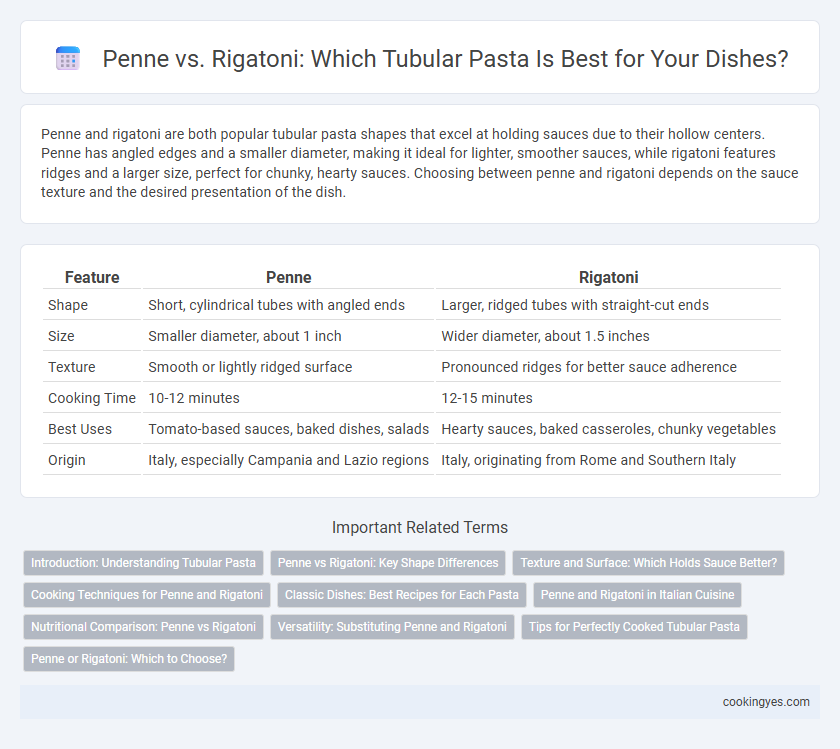Penne and rigatoni are both popular tubular pasta shapes that excel at holding sauces due to their hollow centers. Penne has angled edges and a smaller diameter, making it ideal for lighter, smoother sauces, while rigatoni features ridges and a larger size, perfect for chunky, hearty sauces. Choosing between penne and rigatoni depends on the sauce texture and the desired presentation of the dish.
Table of Comparison
| Feature | Penne | Rigatoni |
|---|---|---|
| Shape | Short, cylindrical tubes with angled ends | Larger, ridged tubes with straight-cut ends |
| Size | Smaller diameter, about 1 inch | Wider diameter, about 1.5 inches |
| Texture | Smooth or lightly ridged surface | Pronounced ridges for better sauce adherence |
| Cooking Time | 10-12 minutes | 12-15 minutes |
| Best Uses | Tomato-based sauces, baked dishes, salads | Hearty sauces, baked casseroles, chunky vegetables |
| Origin | Italy, especially Campania and Lazio regions | Italy, originating from Rome and Southern Italy |
Introduction: Understanding Tubular Pasta
Tubular pasta varieties like Penne and Rigatoni are defined by their hollow, cylindrical shapes, designed to capture sauces within their tubes. Penne typically features a smaller diameter with diagonally cut ends, enhancing sauce absorption and creating a distinctive texture. Rigatoni, larger and ridged with straight-cut edges, offers a meatier bite and excels in holding chunky sauces and baked pasta dishes.
Penne vs Rigatoni: Key Shape Differences
Penne features a cylindrical shape with angled, diagonal cuts at both ends, creating a sleek, pointed appearance that enhances sauce absorption. Rigatoni is larger, with straight-cut ends and ridged exterior walls, designed to hold thicker, chunkier sauces within its wider tube. These distinct shape differences affect how each tubular pasta interacts with various types of sauces and recipes.
Texture and Surface: Which Holds Sauce Better?
Penne and Rigatoni both excel at holding sauce due to their tubular shapes, but Rigatoni's larger diameter and pronounced ridges offer a chunkier texture that clings to thicker, hearty sauces like Bolognese or sausage ragu more effectively. Penne's smaller size and smoother surface make it ideal for lighter, creamier sauces that coat the pasta evenly without overwhelming its delicate texture. The slightly curved shape of Penne also creates pockets that trap sauce, enhancing each bite with balanced flavor.
Cooking Techniques for Penne and Rigatoni
Penne and rigatoni require different cooking techniques to maximize their texture and sauce-holding capabilities; penne, with its smaller diameter and smooth or ridged surface, cooks faster and benefits from al dente preparation to maintain firmness. Rigatoni's larger, ridged tubes need slightly longer boiling times to achieve the perfect tender bite, making it ideal for hearty sauces that cling to its ridges. Properly timed cooking ensures penne remains versatile for both baked dishes and cold pasta salads, while rigatoni enhances robust, chunky sauces in traditional Italian recipes.
Classic Dishes: Best Recipes for Each Pasta
Penne is ideal for baked pasta dishes like Penne alla Vodka, where its diagonal edges hold sauces beautifully, enhancing flavor absorption. Rigatoni's ridged, larger tubular shape is perfect for hearty recipes such as Rigatoni alla Norma, providing an excellent texture that clings to rich, chunky sauces. Both pastas excel in traditional Italian cuisine, with penne favored for smooth sauces and rigatoni preferred for thick, rustic preparations.
Penne and Rigatoni in Italian Cuisine
Penne and Rigatoni are iconic tubular pasta shapes in Italian cuisine, each offering unique texture and sauce adherence. Penne, with its smooth surface and angled ends, excels at holding smooth or creamy sauces, making it ideal for dishes like Penne alla Vodka. Rigatoni, characterized by larger, ridged tubes and straight-cut edges, captures chunky sauces and baked ingredients, commonly used in rich ragus and baked pasta recipes such as Rigatoni al Forno.
Nutritional Comparison: Penne vs Rigatoni
Penne and rigatoni, both tubular pastas, offer similar nutritional profiles with slight variations in calorie and carbohydrate content. Penne typically contains around 200 calories and 42 grams of carbohydrates per cooked cup, while rigatoni has approximately 210 calories and 43 grams of carbohydrates per cooked cup. Protein and fiber levels remain comparable, making both options suitable for balanced meals depending on personal texture preference.
Versatility: Substituting Penne and Rigatoni
Penne and rigatoni both excel in versatility as tubular pasta, making them ideal substitutes in various recipes. Penne's smaller, diagonal-cut tubes offer a lighter texture suited for delicate sauces, while rigatoni's larger, ridged structure better captures hearty, chunky sauces for robust dishes. Swapping one for the other allows cooks to adjust mouthfeel and sauce retention without compromising the dish's overall flavor profile.
Tips for Perfectly Cooked Tubular Pasta
For perfectly cooked tubular pasta like penne and rigatoni, use a large pot with plenty of salted boiling water to prevent sticking and ensure even cooking. Stir occasionally and taste frequently during the last few minutes to achieve al dente texture, as rigatoni typically requires slightly longer cooking times due to its larger size. Draining pasta immediately and tossing with sauce helps maintain texture and prevents overcooking.
Penne or Rigatoni: Which to Choose?
Penne offers a versatile shape with angled edges that capture sauces effectively, making it ideal for both creamy and chunky dishes. Rigatoni, with its larger diameter and ridged surface, holds thicker sauces and baked layers better, delivering a hearty texture. Choosing between penne and rigatoni depends on sauce consistency and desired bite, with penne suited for lighter preparations and rigatoni perfect for robust, layered meals.
Penne vs Rigatoni for Tubular Pasta Infographic

 cookingyes.com
cookingyes.com